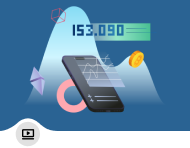The world’s largest exchange market is the foreign exchange or Forex FX market, which trades more than $6 trillion in stocks around the world daily. The scale of the potential global profit is huge, albeit coupled with the potential for substantial risks. All of this makes this a fast-paced and competitive environment for finance traders and their futures.
For anyone who wants to try trading and join the millions of traders worldwide, having the right knowledge and skills is a definite requirement. The best way is to start learning from the best-structured Forex trading course that is on offer and one that offers the best reviews. So enjoy expert training at an excellent price and let us teach you everything you need to know!
What to Look for in a Currency Trading Course
Forex trading courses are ideal for anyone interested in Forex or stock trading in a range of markets. They cater to traders at any level, whether complete beginners for those just starting out, moderately experienced traders, or even professionals in the field looking to refine their skills and increase their education. Such courses can help everyone at every stage.
Learn to Trade Forex from the Experts
Picking a course that is taught by traders with years of professional experience and who have worked as Forex traders in companies for many years is a great starting point. Their years of experience will give you free practical insights into the world of trading on top of the theoretical knowledge that they can also offer.
Hands-on trading experience
The best courses provide thorough hands-on experiences through simulations and live market analysis with demo accounts. This gives you full practical knowledge and understanding of how to execute trades and how to manage risks in market trading.
Interactive Learning Modules
Interactive learning courses provide content complete with videos, quizzes, and live sessions. Compared to traditional learning methods, this keeps students engaged and entertained while they learn trading. It also helps them retain the information more easily.
Live Currency Market Analysis Sessions
Live market sessions show students expert traders working during real-time market hours. They can watch them analyze market conditions, make trade decisions, and identify trade opportunities. This approach bridges the gap between theory and real application and gives students a good start in trading strategy.
Community Support and Mentorship
There is a strong community support system for these types of courses. Students have access to a network of fellow learners and experienced mentors who provide guidance, share insights, and offer feedback. This support is a great source of information, particularly for new traders navigating the market for the first time.
Course Offerings
A wide and varied range of courses is available, designed to meet the needs of traders at different levels. The courses are structured to allow students to build their knowledge progressively, starting with the basics and then advancing to more sophisticated strategies later.
Beginner Course: Mastering the Basics of Trading Forex
Designed for the complete beginner, this kind of course will teach you all of the fundamentals of how Forex trading works with an introduction to Forex, including Forex terminology, how currency pairs work, and how to open and manage a trading account.
Core Topics
Beginner courses typically start by introducing students to trading terminology, understanding currency pairs and types of orders, choosing a Forex broker, setting up a trading account, and learning how to buy and sell.
Learning Formats
With the basics laid down, students can now engage with the material at their own pace to fully grasp all of the concepts. This is done through easy-to-follow modules that include video tutorials and interactive content.
Final Goal
By the time the course is finished, students will have a solid Forex education, understanding how the Forex market operates, how to place trades, and how to navigate the trading platform.
Intermediate Course: Building a Strong Trading Foundation
For anyone who already has a basic understanding of trading, Intermediate Courses offer a more in-depth look at the market’s technical and fundamental analysis and how it works. Such courses focus on developing the skills necessary to make an informed trading plan and decisions based on market data and economic indicators.
Core Topics
You will typically start with technical analysis (chart patterns, indicators, and oscillators), fundamental analysis (economic indicators, news events), and risk management strategies.
Learning Format
This part of the course is designed for more hands-on experience with practical examples and exercises that allow students to apply their knowledge to real market conditions. There are also live market analysis sessions where students can observe experts in action.
Final Goal
You will learn to identify trading opportunities using technical and fundamental analysis, manage risks effectively, and develop a more sophisticated approach to trading.
Advanced Course: Mastering Professional Trading Strategies
Tailor-made for experienced traders who want to refine their skills and strategies, advanced courses go deep into complex topics such as algorithmic trading, understanding macroeconomic factors, and applying professional strategies to enhance profitability.
Core Topics
You will start with advanced risk management, algorithmic trading, macroeconomic factors influencing the currencies market, professional trading strategies, and trading psychology.
Learning Format
This part of the course typically provides a deeper look at more complex content through case studies, extremely detailed lectures, and lots of practical simulations. The emphasis is on using advanced platforms and tools, including trading bots and automated systems.
Final Goals
Students will finish with extensive knowledge and improved skills, advanced trading strategies, and a professional approach to currency trading.
Specialized Courses: Day Trading, Swing Trading, and Long-Term Investing
Specialized courses offer training that is aimed at specific trading strategies. The classes are designed for traders who want to specialize in one area of trading, whether they prefer short-term trading techniques or long-term investment strategies for investors.
Core Topics
These typically include lessons on Day trading (short-term strategies), swing trading (medium-term strategies), and long-term investing (position trading, capital preservation).
Learning Format
Lessons are designed for those who have a basic understanding of trading and would like to explore specific strategies in more detail. They include highly detailed and specialized case studies, real-world examples, and practical applications.
Final Goal
By the end, you will have developed a fully comprehensive understanding of the various trading strategies and learn how to apply them to different market conditions.
How Currency Trading Courses Work
Currency trading courses are designed and structured to offer a flexible and interactive learning experience. The process is simple and designed to ensure that students can learn at their own pace while receiving the support they need to succeed.
Step 1: Enroll in a Course
The first step is to pick a course based on your current experience level and your future trading goals. Each course is clearly broken down, making it easy to choose the right one. After selecting a course, you can sign up and get instant access to the learning materials.
Step 2: Learn Through Interactive Modules and Videos
The courses have instruction videos and interactive modules that contain all of the key concepts. They are designed to be engaging and easy to understand, allowing students to learn at their own pace. All of the content is structured, so students build on their knowledge step by step.
Step 3: Practice with a Demo Trading Account
Practical experience is one of the most important things about learning and students are encouraged to practice with a demo trading account. This allows them to use their skills in real market conditions without risking any actual money losses. The demo account acts as a guide and is a valuable tool for reinforcing the lessons learned in the courses.
Step 4: Get Mentorship and Feedback
As you progress through each of the courses, you will have access to mentorship and feedback from experienced traders. You will have one-on-one support that guarantees that you receive personalized guidance and can address any questions or concerns you have along the way.
Step 5: Trade with Confidence in Live Markets
Once you’ve completed the courses and gained practical hands-on experience, you will be ready to start trading on the real live financial market. With the skills and knowledge acquired through the courses, you will be able to approach the market with confidence and a well-rounded understanding of stock trading.
Choose PipUP for Your Currency Trading Course
Here at PipUP, we believe that with the right education and support, anyone can master the markets and create lasting wealth with confidence. Are you keen to find out more about currency trading courses? Contact our team today to learn more about upcoming course dates and enrollment options!
Frequently Asked Questions (FAQ)
As a Forex trader, how long does it take to complete a currency trading course?
Each course’s duration depends on its complexity and the student’s pace of learning. On average, introduction courses can take one to two weeks, while advanced courses may take a month or more.




